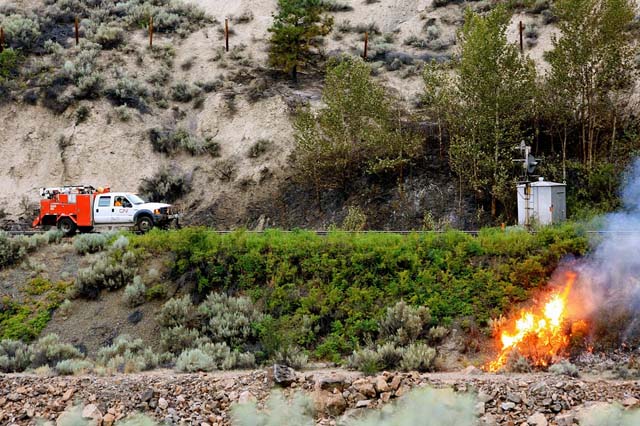|


A fire on the railway line west of Spences Bridge - 25 Jul 2013 Dwayne Rourke.
14 August 2013
Chain of Fires Blamed on Rail Car
Two fires erupted simultaneously along stretches of the CN Rail line west of Spences Bridge on the night of
11-12 Aug 2013. The closest location was at what locals call Mud Lake while the other was across the Thompson River from Gold Pan provincial
park. Fire suppression using helicopters began on the morning of 12 Aug 2013 - Dwayne Rourke - Click to enlarge the small photos above.
Spences Bridge British Columbia - A series of wildfires along a CN Rail track near Spences Bridge is only the latest evidence of
railway companies' inadequate fire mitigation measures, says one local.
"A lot of people in the town last night were up late checking out the fire, wondering if it would be hitting Spences Bridge," said James Kohut.
"It's a terrorizing thought to think you may be facing a wall of fire. You never know when it's going to come into town."
On Sunday night, wildfires were sparked at various points along about six kilometres of track starting just outside Spences Bridge and ending at Goldpan
Provincial Park.
As dry brush was igniting shortly after 10 p.m., a CP Rail coal car that had bucked the track was being dragged over several kilometres through the area before
the engineer noticed the derailment.
Lytton RCMP received a call from CN Rail at 10:23 p.m., said Const. Mike Phillips.
"They believed that the fires were accidentally ignited as a result of a single car that had derailed on the rail system," he said. "The car was
dragged for some time before the derailment was noticed and the train was brought to a stop."
By Monday morning, Kamloops Fire Centre had helicopters and ground crews attacking two blazes, one covering 5.2 hectares at Goldpan Park and another 2.1
hectares in size, about a kilometre from Spences Bridge.
Near midday, firefighters had beaten the blazes back to ground smoldering with "minimal visible flame," said fire information officer Melissa Welsh.
No structures were jeopardized.
The incident is no longer in the hands of the RCMP after police determined no crime had been committed, said Phillips.
That leaves the investigation with the province and CP Rail, which haven't yet determined that the derailment and fires were connected.
"It's too early to speculate that the train is the cause of these wildfires," said Welsh.
However if a culprit is found, the cost of fighting the fires could be recuperated as outlined in the Wildfire Act, she said.
CP Rail will hold an internal investigation, said CP spokesperson Kevin Hrysak.
"I know there were some reports of fires adjacent to the track near Spences Bridge," he said.
The Transportation Safety Board did not immediately respond to inquiries over its involvement. Hrysak said he didn't believe the federal agency would be
investigating.
Kohut has for years sounded the alarm over railway-related fires in his area.
"You can't have hot chunks of metal flying off and falling into the bush over here," he said. "Look at Environment Canada statistics. This is
the hottest place in Canada."
He alleges rail operators' negligent train and railway maintenance caused the weekend fires as well as others in the past.
"They're too cheap to maintain their railways and they don't seem to care that fires are being sparked," he said.
Hrysak rejects the notion that CP is sacrificing safety for costs.
He said CP uses spark arresters in the locomotive stacks, a composite break shoe that creates fewer sparks, and a vegetation management program.
CN spokesperson Emily Hamer said CN also conducts vegetation management along its lines to mitigate fires.
The corporation also undertakes scheduled patrols to detect fires and when temperatures are high, increases inspections.
Also, crews have fire suppression equipment like water and foam in their work vehicles.
Sylvie Paillard.



Vancouver Island
British Columbia
Canada
|